Puumala hantavirus infections in bank vole populations: host and virus dynamics in Central Europe
- PMID: 28245831
- PMCID: PMC5331674
- DOI: 10.1186/s12898-017-0118-z
Puumala hantavirus infections in bank vole populations: host and virus dynamics in Central Europe
Abstract
Background: In Europe, bank voles (Myodes glareolus) are widely distributed and can transmit Puumala virus (PUUV) to humans, which causes a mild to moderate form of haemorrhagic fever with renal syndrome, called nephropathia epidemica. Uncovering the link between host and virus dynamics can help to prevent human PUUV infections in the future. Bank voles were live trapped three times a year in 2010-2013 in three woodland plots in each of four regions in Germany. Bank vole population density was estimated and blood samples collected to detect PUUV specific antibodies.
Results: We demonstrated that fluctuation of PUUV seroprevalence is dependent not only on multi-annual but also on seasonal dynamics of rodent host abundance. Moreover, PUUV infection might affect host fitness, because seropositive individuals survived better from spring to summer than uninfected bank voles. Individual space use was independent of PUUV infections.
Conclusions: Our study provides robust estimations of relevant patterns and processes of the dynamics of PUUV and its rodent host in Central Europe, which are highly important for the future development of predictive models for human hantavirus infection risk.
Keywords: Myodes glareolus; Population dynamics; Puumala virus seroprevalence; Space use; Survival.
Figures
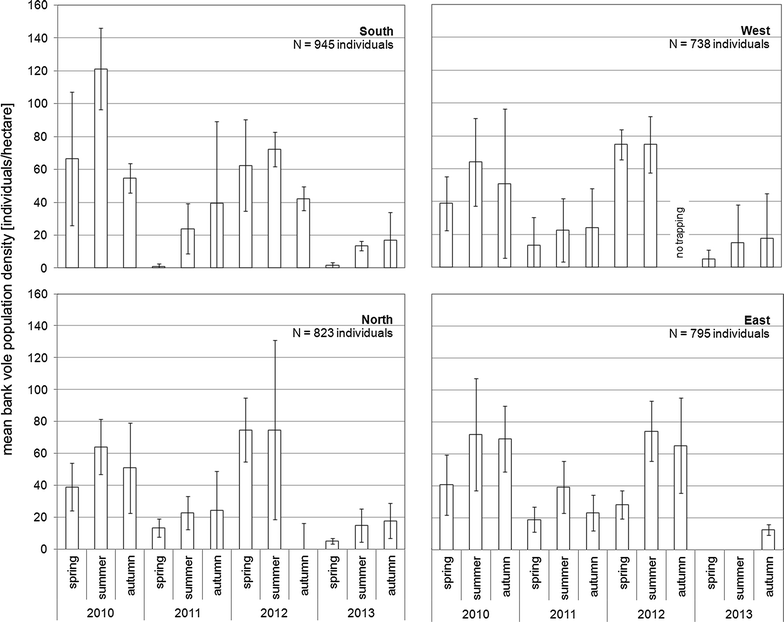

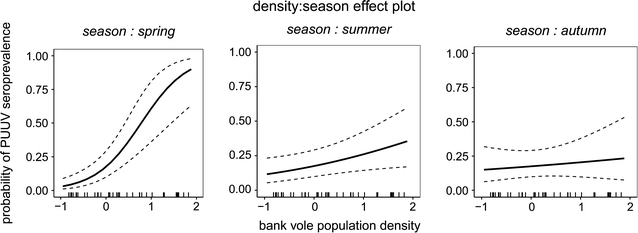

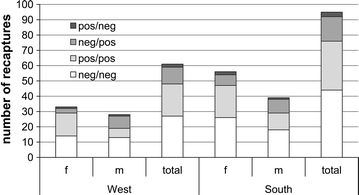
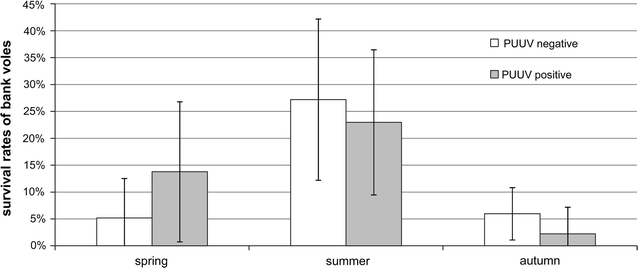
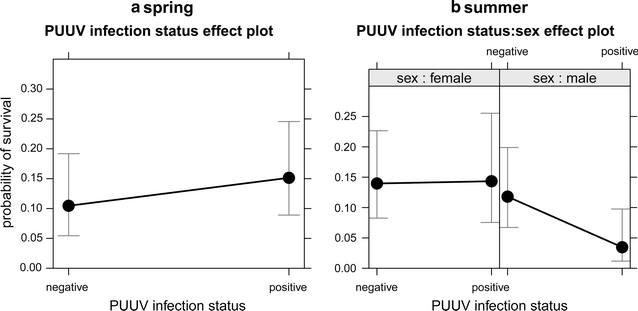
Similar articles
-
Validation of the Puumala virus rapid field test for bank voles in Germany.Epidemiol Infect. 2017 Feb;145(3):434-439. doi: 10.1017/S0950268816002557. Epub 2016 Nov 3. Epidemiol Infect. 2017. PMID: 27806736 Free PMC article.
-
Population, environmental, and community effects on local bank vole (Myodes glareolus) Puumala virus infection in an area with low human incidence.Vector Borne Zoonotic Dis. 2008 Apr;8(2):235-44. doi: 10.1089/vbz.2007.0160. Vector Borne Zoonotic Dis. 2008. PMID: 18370592
-
Microevolution of bank voles (Myodes glareolus) at neutral and immune-related genes during multiannual dynamic cycles: Consequences for Puumala hantavirus epidemiology.Infect Genet Evol. 2017 Apr;49:318-329. doi: 10.1016/j.meegid.2016.12.007. Epub 2016 Dec 9. Infect Genet Evol. 2017. PMID: 27956196
-
Hantavirus Research in Finland: Highlights and Perspectives.Viruses. 2021 Jul 26;13(8):1452. doi: 10.3390/v13081452. Viruses. 2021. PMID: 34452318 Free PMC article. Review.
-
Spatial and Temporal Epidemiology of Nephropathia Epidemica Incidence and Hantavirus Seroprevalence in Rodent Hosts: Identification of the Main Environmental Factors in Europe.Transbound Emerg Dis. 2017 Aug;64(4):1210-1228. doi: 10.1111/tbed.12494. Epub 2016 Mar 20. Transbound Emerg Dis. 2017. PMID: 26996739 Review.
Cited by
-
Epidemiology and Clinical Course of Haemorrhagic Fever with Renal Syndrome in New Endemic Area for Hantavirus Infection in Croatia.Life (Basel). 2023 Aug 18;13(8):1767. doi: 10.3390/life13081767. Life (Basel). 2023. PMID: 37629623 Free PMC article.
-
Of city and village mice: behavioural adjustments of striped field mice to urban environments.Sci Rep. 2020 Aug 3;10(1):13056. doi: 10.1038/s41598-020-69998-6. Sci Rep. 2020. PMID: 32747632 Free PMC article.
-
Spatial dynamics of a zoonotic orthohantavirus disease through heterogenous data on rodents, rodent infections, and human disease.Sci Rep. 2019 Feb 20;9(1):2329. doi: 10.1038/s41598-019-38802-5. Sci Rep. 2019. PMID: 30787344 Free PMC article.
-
Ecological determinants driving orthohantavirus prevalence in small mammals of Europe: a systematic review.One Health Outlook. 2025 Mar 26;7(1):15. doi: 10.1186/s42522-025-00136-w. One Health Outlook. 2025. PMID: 40134030 Free PMC article. Review.
-
Novel polyomavirus in the endangered garden dormouse Eliomys quercinus.Virol J. 2024 Nov 27;21(1):309. doi: 10.1186/s12985-024-02581-x. Virol J. 2024. PMID: 39605065 Free PMC article.
References
-
- Schlegel M, Jacob J, Krüger DH, Rang A, Ulrich RG. Hantavirus emergence in rodents, insectivores and bats: what comes next? In: Johnson N, editor. The role of animals in emerging viral diseases. Boston: Academic Press; 2014. pp. 235–292.
-
- Plyusnin A, Morzunov SP. Virus evolution and genetic diversity of hantaviruses and their rodent hosts. In: Schmaljohn CS, Nichol ST, editors. Hantaviruses. Berlin: Springer-Verlag; 2001. pp. 47–75. - PubMed
-
- Drewes S, Turni H, Rosenfeld U, Obiegala A, Straková P, Imholt C, Glatthaar E, Dressel K, Pfeffer M, Jacob J et al. Reservoir-driven heterogeneous distribution of recorded human Puumala virus cases in South–West Germany. Zoonoses Public Health. 2016. - PubMed
Publication types
MeSH terms
Substances
LinkOut - more resources
Full Text Sources
Other Literature Sources

